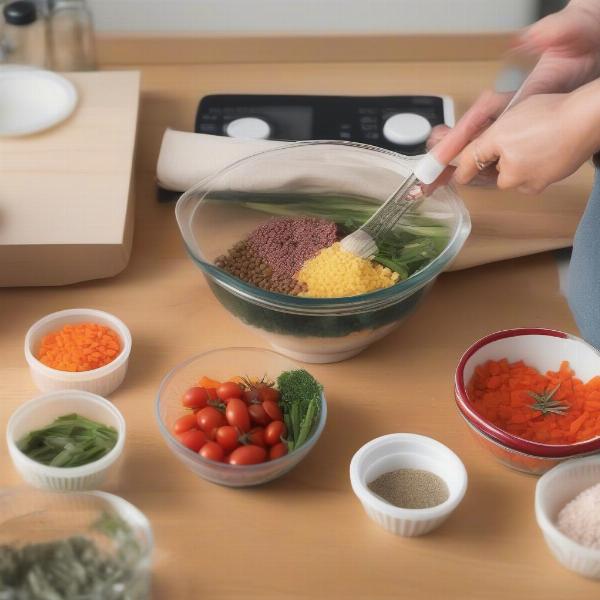Managing diabetes in dogs can be challenging, but a crucial aspect of their care involves a carefully planned diet. A homemade diet for diabetic dogs offers potential benefits like controlling blood sugar levels and weight management, but it’s essential to understand the nuances of creating a balanced and effective meal plan. This comprehensive guide will equip you with the knowledge to prepare nutritious, homemade meals for your diabetic dog.
Understanding the Dietary Needs of a Diabetic Dog
Diabetic dogs require a diet that helps regulate blood sugar levels and provides sustained energy. This means focusing on low-glycemic index foods that release glucose slowly into the bloodstream, preventing sudden spikes. Fiber plays a vital role in this process, promoting satiety and aiding digestion. Additionally, a diabetic dog’s diet should be carefully balanced in terms of protein, carbohydrates, and fats, tailored to their specific needs and activity level.
Key Ingredients for a Homemade Diabetic Dog Diet
Choosing the right ingredients is paramount to the success of a homemade diabetic dog diet. Lean protein sources like chicken breast, fish, and turkey are excellent choices. Complex carbohydrates, such as brown rice, quinoa, and sweet potatoes, provide sustained energy without causing rapid blood sugar fluctuations. Fiber-rich vegetables like green beans, broccoli, and carrots add bulk to the diet and promote digestive health.
Why Lean Protein is Essential
Lean protein is a crucial component of a diabetic dog’s diet, providing essential amino acids for muscle maintenance and repair without contributing to excess weight gain, which can exacerbate diabetes. Opting for lean protein sources also helps regulate blood sugar levels.
 Preparing a homemade meal for a diabetic dog
Preparing a homemade meal for a diabetic dog
Creating a Balanced Meal Plan
Creating a balanced meal plan involves calculating the correct proportions of protein, carbohydrates, and fats based on your dog’s individual needs. Consult your veterinarian to determine the appropriate caloric intake and nutrient ratios. It’s vital to avoid feeding your diabetic dog table scraps, sugary treats, or high-glycemic index foods. Consistency in feeding times and portion sizes is also essential for managing blood sugar levels effectively.
Portion Control and Feeding Schedule
Maintain a regular feeding schedule to ensure consistent blood sugar levels throughout the day. Divide your dog’s daily food allowance into two or three smaller meals. Avoid free-feeding, as it makes it difficult to monitor intake and regulate blood sugar.
Monitoring Your Dog’s Response
Regularly monitor your dog’s blood glucose levels and weight after implementing a homemade diet. Consult with your veterinarian to make adjustments to the meal plan as needed. Observe your dog for any changes in appetite, energy levels, or thirst, which could indicate the need for adjustments to the diet. diabetic dog treats can be incorporated into a diabetic dog’s diet, but choose wisely.
Conclusion
A homemade diet for diabetic dogs can be a valuable tool in managing their condition, offering greater control over ingredients and portion sizes. Remember, close collaboration with your veterinarian is crucial to ensure the diet meets your dog’s specific needs and helps maintain optimal health. can dogs eat monk fruit? Find out what alternative sweeteners are safe for your pup.
FAQ
- How often should I feed my diabetic dog? It’s generally recommended to feed a diabetic dog two to three small meals per day, maintaining a consistent schedule.
- What are some signs my dog’s diet needs adjusting? Changes in appetite, thirst, urination frequency, or energy levels can indicate a need for dietary adjustments.
- Can I give my diabetic dog any treats? While some treats are acceptable, choose dog treats for diabetic dogs specifically formulated for diabetic dogs and offer them in moderation.
- Is a homemade diet suitable for all diabetic dogs? Not all dogs thrive on a homemade diet. Consult your veterinarian to determine if it’s the right choice for your dog’s individual needs and circumstances.
- What should I do if my dog’s blood sugar levels are unstable despite a homemade diet? Contact your veterinarian immediately to discuss potential adjustments to the diet or medication.
- Are there any specific supplements recommended for diabetic dogs on a homemade diet? Your veterinarian can assess your dog’s individual needs and recommend appropriate supplements if necessary.
- How can I transition my diabetic dog to a homemade diet safely? Gradually introduce the new diet over several days, mixing increasing amounts of the homemade food with the previous food to prevent digestive upset. diabetes dog food can help in the transition.
ILM Dog is a leading international pet website dedicated to providing expert advice and resources for dog owners worldwide. We offer a comprehensive range of information on dog breeds, health, training, nutrition, grooming, and more. Our expert articles, like this one on homemade diets for diabetic dogs, are designed to help you provide the best possible care for your furry companion. Whether you’re a new dog owner or a seasoned pro, we have the resources you need to navigate every aspect of dog ownership. Contact us at [email protected] or call us at +44 20-3965-8624 for further assistance. Learn more about what we do at ILM Dog. dog treats for dogs are a great way to show your dog some love!